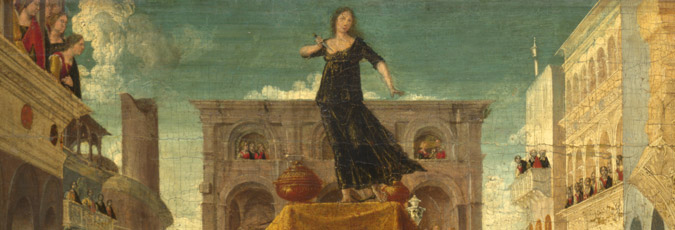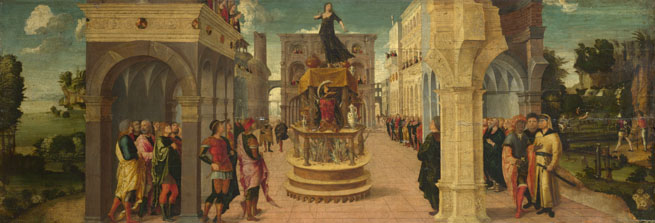Liberale da Verona
'Dido’s Suicide', about 1500
Oil on poplar, 42.5 x 123.2 cm
NG1336
This painting, probably made to be set into a piece of domestic furniture, depicts one of the most tragic stories of deserted love. Such paintings were often commissioned around the time of marriage. Although they were not aimed exclusively at women, they often – like this painting – told stories of virtuous females, who sacrificed themselves for the sake of their family and their ‘patria’.
Liberale’s painting is based on Book 4 of Virgil’s ‘Aeneid’, which tells of the hopeless love of the widowed Dido, Queen of Carthage for the wandering Trojan prince Aeneas – hopeless because Jupiter, king of the gods, had decreed that Aeneas’s destiny lay in Italy, with the foundation of Rome as a ‘new Troy’. Virgil’s Latin epic (left unfinished at the poet’s death in 19 BC) provided an imaginative prehistory for what was, by his day, the very long-standing enmity between the peoples of North Africa and the Roman Empire. Like Ovid’s ‘Metamorphoses’, Virgil’s great poem was well known to 15th-century Italians, and indeed it remains part of the common European cultural heritage today.
The tragedy of Dido
Here, Dido plunges a dagger into her chest as she stands on a funeral pyre. The pyre is topped with a hexagonal piece of furniture, perhaps the bed (albeit a strangely shaped one) in which Dido had intended to celebrate the marriage she believed she had contracted with Aeneas. But he had departed for his ship, and was preparing to cross the Mediterranean to his new promised land. Dido’s regal dignity is palpable; so is her deep distress and anger, conveyed by her positioning of Aeneas’s helm and armour – symbols of arms and of the man, to paraphrase the opening of Virgil’s poem – at her feet. Flames lap around the platform on which they are placed, ready to consume Aeneas’s possessions and the body of the queen he had abandoned.
The architectural setting makes this private tragedy into a public event. Spectators, probably the members of her court, crowd the arcades and balconies of the portico and palaces around Dido’s pyre, and spill out into the street. The artist has used the architecture to divide the painting into three approximately equal sections: Dido herself; the watching bystanders; and the landscape at the far ends of the panel. In the countryside at the right, military exercises are taking place. Presumably this is a proleptic reference to Aeneas’s future military adventures in Italy. The seascape at the left-hand side of the panel probably alludes to his voyages across the Mediterranean: to Dido’s court at Carthage, and then westwards towards Latium. Cassone paintings such as this often play havoc with time, linking narrative episodes which may have happened years apart, and Liberale’s panel is no exception.
A north Italian piazza
The piazza – flanked by civic buildings, loggias and porticos – recalls those found in several north Italian cities, such as Brescia, Verona or Vicenza. Stories of antiquity were often represented by Italian 15th-century artists as if they had happened in partially recognisable surroundings, although they were never intended to translate ancient history into contemporary Italy. An apt comparison is provided by the Florentine Biagio di Antonio’s depiction of Troy, in a pair of paintings now in the Fitzwilliam Museum (figs. 1 and 2). In their amalgamation of the ancient and modern – classical circus, triumphal column, a domed church resembling Florence’s Santa Maria del Fiore, town gates, and a triumphal arch – they represent a type very common in northern Italy.


Liberale da Verona prepared the architecture of his painting carefully. Lines incised into the gesso, still visible when the picture is viewed from the side in raking light, were used to properly proportion the buildings. However, the architecture was drawn freehand, and although the picture appears to be equally proportioned, neither the buildings nor the implied vanishing point in the middle of Dido’s feet are absolutely symmetrical. The architectural content of the painting was also consciously planned. It contains both Renaissance and ancient structures, shown at different points in their lives.
This mixture of architectural types was particularly attuned to the architectural reality of Verona in the late 15th century. Verona was then – as it is today – the Italian city with the most surviving Roman architecture after Rome itself. The circus or amphitheatre in Liberale’s picture is complete – as of course Verona’s amphitheatre still is, in essentials, and the distant building glimpsed at the end of the right-hand street is based on Verona’s surviving Roman gate, the Porta Borsari.
Other Classical structures are less complete. A ruined pier, with applied pilaster shafts, stands at the right foreground. At least three arches would have sprung from it, so it is evidently the remains of a large and impressive ‘all’antica’ building. Behind it we see a semi-circular recessed apse (partially built from brick), with a vaulted arcade receding into the middle distance, which looks unfinished rather than ruinous. This particular mixture of architectural forms conveys a sense both of historical distance, and of proximity to the contemporary world, as if ‘architectural time’ is separate from real time.
This approach to architectural context was particularly appropriate to the interpretation of Dido’s death in late 15th-century Italy. Women were encouraged to emulate Dido’s devotion to her lineage, and to her husband’s memory – but not of course her suicide, a mortal sin. It is by means of architecture that Liberale makes the mixed messages of Dido’s tragic end so evident.
Selected literature Davies 1961, pp. 283–4; Del Bravo 1967, p. 79.
This material was published in April 2014 to coincide with the National Gallery exhibition 'Building the Picture: Architecture in Italian Renaissance Painting'.
To cite this essay we suggest using
Caroline Campbell, ‘Liberale da Verona, Dido's Suicide’ published online 2014, in 'Building the Picture: Architecture in Italian Renaissance Painting', The National Gallery, London, http://www.nationalgallery.org.uk/research/research-resources/exhibition-catalogues/building-the-picture/architectural-time/liberale-da-verona-dido-suicide


